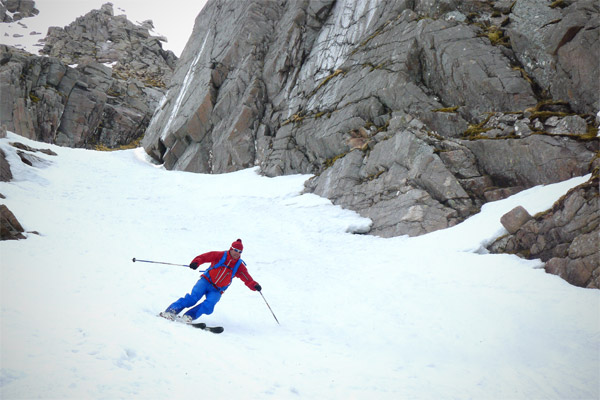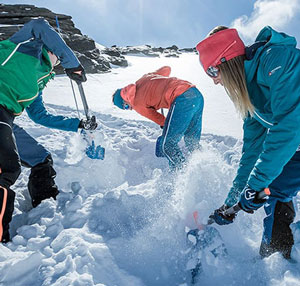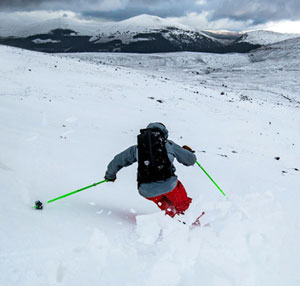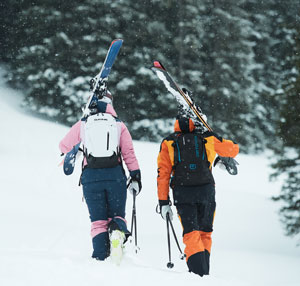Top 10 Backcountry Skiing Tips
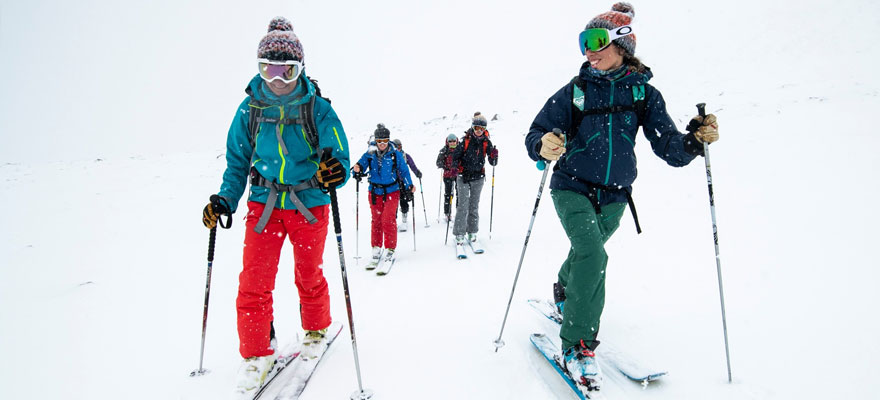
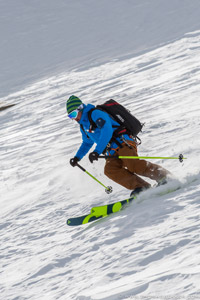
There’s no doubt this winter is going to be different for all skiers and it’s uncertain whether ski holidays as we know them will be possible. Luckily for us in the UK, Scotland offers fantastic backcountry skiing opportunities and it may be the perfect year to try it out for the first time. Head of Skiing at Glenmore Lodge, Andy Townsend gives us his top tips for a succesful backcountry skiing experience.
"It's a miracle that I managed to graduate from University with a half decent degree. I had a flexible approach to my studies and spent a significant portion of my time climbing and skiing, I was learning lots, but not all academic.'
"One January I joined a group of friends on a holiday in The Alps. We were taking advantage of the cheap deals and managed to get a package to the ski paradise of Tignes in the heart of Espace Killy, a huge playground for snowsports enthusiasts with acres of off piste terrain and a network of efficient lifts to whizz us aboout.'
"We arrived in the middle of a snow storm. Huge snowflakes fell from the sky and as we moved into our first floor apartment there was already half a metre of snow on the ground. We awoke to over a metre of snow and it was still dumping. Due to the avalanche risk there were a only couple of lifts working so we set about skiing the buried pistes. Now, our group were quite experienced skiers but we had never skied snow this deep and so began a very steep learning curve.'
"Over the course of the week we learnt how to ski in the deeper and deeeper snow, how to avoid falling and disappearing like a submarine, and how to keep the snow out of every part of clothing. By the end of the week our 1st floor apartment had become a ground floor ski in and out residence. We had experienced avalanches, fallen into holes and skied over the roof of a chair lift station – it was epic and knowing what I do now it's a miracle that I was able to return to university at all.'
"Since those halcyon, carefree days of my youth I have gone on to qualify as a mountain guide and have introduced clients to the joys of backcountry skiing throughout Europe and Canada. I still think back to that week in Tignes and still teach some of the lessons from that epic week.'
"So here in no particular order are my top ten tips for happy and successful backcountry skiing. These tips are also relevant to ski touring and side country or even those skiers who are getting to grips with piste skiing but keep looking longingly at the untouched snow beyond the piste markers..."
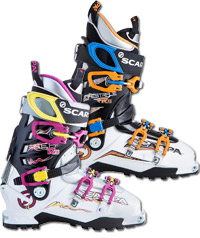
1 – Boots
This might seem obvious, but you would be surprised by how many folks don’t look after their feet and select the wrong boot for them and their chosen activity. With a huge range of boots available and nearly every manufacture producing boots with hike/ski modes, what do you buy?
You should start by having a good look at yourself; how much piste/off piste do you do, are you a ski tourer focused on skinning up or are you going to straight line the Glacier Rond in two turns. Don’t listen to the opinions from everyman and his dog, take the advice of a specialist boot fitter and make your own decision. But here are some guidelines to help:
Lightweight touring boots are comfy for walking and skinning but will compromise your ability to drive a big fat ski hard. There are no shortage of skiers who want to appear 'cool' by using light boots and try to ski like Seth Morrison, but light boots and big skis doesn’t work, it's like putting skinny tyres on a Ferrari, it won't drive as well – simple.
A freeride boot, like a Scarpa freedom SL is probably the best compromise, it skis like an alpine boot but will be comfy skinning and walking. It was developed with help from Chris Davenport, who knows a thing or two about skiing.
View our range of Backcountry Ski Boots
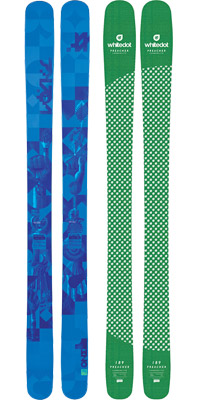
2 – Choose your weapon carefully
It never fails to amaze me how many different types of ski there are, every shape, size and colour. It's a bewildering array of technology and marketing and the only way to cope is to buy a 'quiver' of skis, at least 3 sets each! Joking aside, try before you buy is a good place to start. There are lots of ski test events around the UK and in the Alps and these will help you make your selection.
There are two basic features you should be looking for in a backcountry ski.
Waist width - this is going to govern how much float you get in soft snow, for a general do everything ski a waist of 90 – 100mm is fine. If it has an early rise tip or rocker this is a good thing as it will help you keep the skis up and make them easier to pivot when things get tricky.
Stiffness - unless you're built like Axel Lund Svindal, go for a soft ski with good torsional stiffness. They will be easier to ski in all types of snow, but will come alive in the soft stuff and leave you grinning from ear to ear. You may look cool, standing in the lift line with a huge, fat, stiff ski but you’ll look like a right plonker when you can't flex them on the slopes.
My favourite skis of this season are the Volk Mantra and Rossignol Soul 7.
You can find our full range of backcountry skis here.
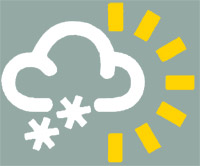
3 – Develop an obsession with the weather and avalanche reports
We all have little routines that are fixed in our daily lives. It might be coffee from Starbucks on the way to work, but for me it's looking at the weather forecast and the avalanche reports. I do it at night after dinner and in the morning again with my cereal and I do it every day without fail. A cursory glance in the morning as you're in the lift queue is simply not enough, this is only setting you up for a massive fail.
You need to have the 'big picture' in your head as you clip into your bindings, what has the weather and snow been doing, not just yesterday but last week and better still, since the start of the season. Having this knowledge combined with a healthy dose of humility will help you have a long and happy ski life.
With mobile apps keeping track of the snow has never been easier, the best of the crop is definitely 'White Risk' from SLF, the Swiss Avalanche Foundation (available on iTunes or Google Play).
4 – Learn to ski
Sounds obvious, and if you're reading this then you can probably already ski, but is your skiing ready for the backcountry? Like many, I learnt to ski on thin planks that were at least 20cm longer than I am tall; they had no float in powder and were difficult to control off piste. With the rise of modern floaty and rockered skis there is no long and difficult learning curve, you can almost clip into a set of bindings point them downhill and hey presto you're skiing like Mike Hattrup, Glen Plake or Scott Schimdt, and herein lies the problem!
There is definitely a steady rise in skiing related injuries, knees and head are the most vulnerable. The skis don't make the skier. They help, but it helps more to get some coaching from a professional and to understand better how to use these innovative shapes to your advantage. You'll have better control of your speed and line and therefore be less prone to skiing too fast and injuring yourself. Good skiing is about balancing the forces from the mountain terrain and yourself. Ski fast with big turns when it's an open slope, and slow down with tight turns when it's rocky or narrow.
5 - Work as a team
Never ski in the backcountry alone, this is a well-used and obvious statement, but the one you never hear is never ski with strangers. You need to know your skiing companions, their style, behaviour and skill level. Pick itineraries and conditions that best suit everyone in the group, not just the best skier. Everyone within the group has a role - to look after each other – the buddy system. Everyone has an equal voice and if someone has a concern about a slope then you have to listen to it and change your plan without recrimination. In the event of an avalanche it will be your buddies rescuing you and visa versa, make the time to practice and rehearse what to do if one of your team triggers an avalanche. Work together to avoid avalanches at all cost, space out, don’t ski at the same time, move from island of safety to island of safety and watch each other at all time like hawks.
6 - Go with a Guide
Without a doubt skiing in the backcountry is dangerous. Hiring a qualified IFMGA mountain guide is a good idea, not only will they help you find the best snow but they will also show you how to manage the risks of backcountry skiing so you can have your own adventures. Don't just go for the first guide you find. Shop about, talk to several. You are looking for someone who suits your personality and with whom you want to spend time. Clipping into your bindings with a guide is an act of friendship and will certainly be one of the best investments you ever make. Check out www.bmg.org.uk for more information on mountain guides and a list of all the qualified British Mountain Guides.
7 – Get a decent rucksack
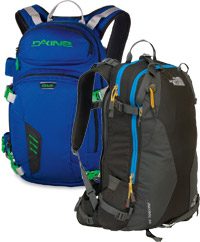
I have a particular dislike of the tiny handbag-sized rucksacks you see folks skiing with. These packs are so small everything is on the outside and there is no room for all the useful stuff you need to carry. As a rule, if it doesn't fit inside your rucksack, get a bigger pack!
Shovel handles strapped to the outside will be lost in powder snow when you crash, tree branches will pluck them off the side of your pack and anyone skiing off piste without a rucksack is an 'avalanche poodle' – stay well clear!
Here is a list of the contents of my 30 litre rucksack, which is the bare minimum that I would ski off-piste with:
- Transceiver – actually strapped to my torso, under several layers and switch on.
- Shovel – metal not plastic
- Probe – you need to know how to use and be practiced with all three.
- Spare hat and gloves
- Spare goggles – on powder days you will need at least 2 pairs so that you can quickly change to a dry pair after a crash
- Spare jacket – in the event of an accident you are no good to your buddies if you go down with hypothermia.
- Flask – the hot juice variety, not the 'nip from the hip' type.
- Food – usually sandwiches if travelling away from the ski area but cereal bars if you’re staying close to the bars and restaurants
- First Aid Kit – a small one each. If the person carrying the first aid is buried in an avalanche you need a spare.
- Mobile Phone – they interfere with avalanche transceivers, so don't risk it, switch it off and pack it away.
- Map, Compass and GPS – how can you call for help if you don't know where you are?
- Multi tool or screwdriver and a small repair kit – for fixing and adjusting bindings, mostly zip ties and gaffa tape.
- Survival bag each or group shelter
View our backcountry essentials
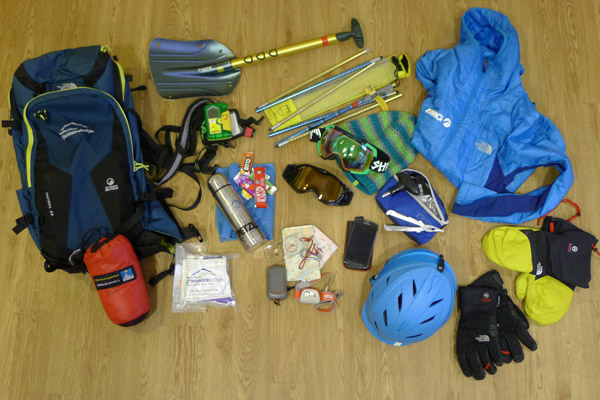
8 – Do an avalanche course
An obvious top tip really, but the only one that may save your life. There are lots of courses available, from really techy science-based to practical ones that concentrate on how to ski in the backcountry. It's worth pointing out that we know more about the surface of the moon than we do about avalanches. We will never be able to accurately predict which slope will avalanche and which won't. If you're hanging on for a pair of avalanche goggles, with a heads up display to show you where to ski, then don’t – that sort of gadget will never exist.
The best defence against avalanches is not to be there, read the avalanche bulletins, watch the weather and ski conservatively sticking to shallow slopes and be aware of the '3 What's':
- What's above you. This could be cornices, steeper slopes or even other skiers, anything that might trigger an avalanche which threatens you.
- What's below you. If you were to be avalanched what is going to happen? Will you be washed over a cliff, or through trees or caught in a gully which will funnel more snow on top of you.
- What's under you. Constantly poking the snow is a good way of getting a feel for how stable the snowpack is, but mountain slopes are very complex so you can never fully predict a slopes stability. If you feel differences in density within the snowpack change aspect, change slope angle or change location. It's better to miss out on the killer powder than be killed.
9 – Have a checklist

I have been skiing for quite a long time, and I am still as keen as I was when I started. My poor wife has endured countless ski holidays when we have skied from the first lift till the last lift, with no stops and definitely no chocolat chaud. This excitement has got the better of me and I have forgotten kit and made foolish decisions in my haste to get fresh tracks. If you're like me, checklists are a brilliant way to remember everything and still be first on the mountain. I have a small laminated card in my rucksack with a list of the contents. I also have a pocket-sized card on which I write out the key facts from the weather forecast and the avalanche bulletin so I can use this information when I am making decisions on the hill. I also have an emergency card with reminders of what to do and who to call in the event of an accident.
Yes, I admit to being a little obsessive around checklists, but I got the idea from a Doctor called Atul Gawande, the author of a book called The Checklist Manifesto: How to get things right. Dr Gawande is credited by the WHO as saving millions of lives by using a simple checklist to help improve situational awareness in the fast moving and challenging world of an operating theatre, so it's a pretty logical step to have the same system to help backcountry skiers in the ever-changing world of avalanches!
10 – Open your eyes
So what is my last top tip? Well, after all the ones about kit, ski technique and avalanche avoidance, the ultimate tip is to simply open your eyes and enjoy the mountains. Skiing in the backcountry is a wonderful experience that enriches your soul and makes you appreciate how amazing the winter landscape really is. It doesn't matter if you haven't got this year's must-have skis or that you can't do a McConkey turn. What does matter is that you venture into this world and come home with some memories that will stay with you forever. So next time you head into the backcountry don't forget your camera, snap some pictures and come home with a smile on your face.
